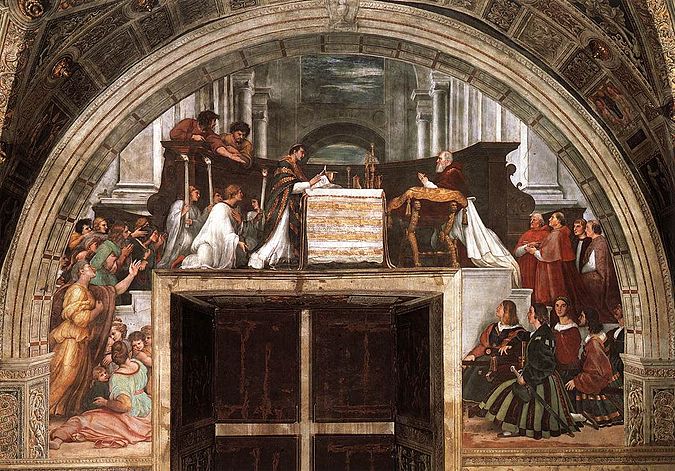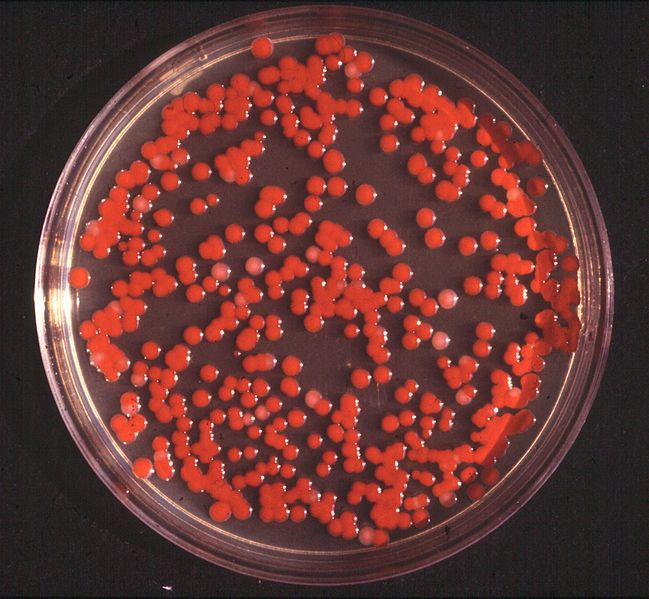Serratia marcescens: Making soggy bread exciting again
It sounds like the opening to an offensive joke1, "What do a toilet bowl and one of the holiest sacraments of the Catholic church have in common?" In fact, it's a very relevant microbial and historical question. Perhaps you've noticed a reddish-pink ring in toilet, around the bathroom sink, or on the walls and and curtain of someone else's shower (surely not your own). The culprit is almost certainly Serratia marcescens and the red pigment it often produces (prodigiosin).
Of miracles and microbes
It turns out that Serratia has been pulling a similar trick on us for at least the last 800 years. Some of you may have guessed what's going on, but let me give you a little background.2
On the Eucharist and transubstantiation.
The rite of communion is central to many forms of Christianity and is definitely a Big Deal in Catholicism. To those not familiar, it is a celebration of the Last Supper and serves as a remembrance of Jesus's sacrifice, which is the defining Big Deal for Christianity. One of the issues is whether the bread and wine used in this rite symbolically represent the body and blood of Jesus, or if there is a literal transubstantiation occuring. To say this is contentious is a bit of an understatement.
Wasn't this about bugs?
Our microbial friend ties in with this if you consider that if the bread were to, oh I don't know, bleed, this would lend a lot of weight to one side of the debate.
The above image is nice, but, honestly, I didn't think it looks a lot like blood. It turns out Serratia can produce a range of reddish hues, and there's an art project which uses it and is quite convincing.
It should come as no surprise then that when some Serratia decided to nibble on bread in Bolsena, Italy in the 13th century, that the Pope declared it a miracle. Such a miracle, in fact, that they created a feast day to celebrate it. Incidentally, if any of you live in Corpus Christi, Texas, you owe your town's name to this microbe, since the city was discovered on that feast day.
This was such a big deal that a century and change later Raphael was hired to decorate one of the walls of the Papal Palace with a frescoe showing the event.

Holy... polenta?
It's one thing for the church to say that communion bread is the literal body of Christ. But what do you do when your mornin' grits start bleedin'? It turns out that if it's the early 1800's and you know about 'wee animalcules', you try to grow and isolate bugs. This is exactly what Bartolomeo Bizio did in Padua in 1819 to discover Serratia, which was then called 'red bread mold'.
This still happens
From time to time, we still see reports of communion wafers (or statues) bleeding. As fans of horror movies know, the Catholic church generally tends towards skepticism these days with cases of miracles and possession. In both these cases, the miraculous status was refuted.
In comparison, a similar recent event in Poland was tested, but they did not look for Serratia. Instead, it was tested for the presence of stuff that looks like human tissue. Conclusion: miracle. However, I bring this up as a great example of how you can subtly trick yourself in science. If you want there to be canals on Mars, and you squint through enough telescopes, you're going to find canals on Mars. Similarly, if you want human tissue to appear in a communion wafer, and you look hard enough, you're going to find stuff that resembles human tissue. A more powerful (indeed, appropriate) experimental approach is to test for things which falsify your hypothesis to avoid confirmation bias. Here we can see how similar phenomena, examined by similar people, with similar levels of technology, arrived at two very different results, simply because of how they test their hypothesis.

What else has Serratia done for(to) us
Once we got to grips with bleeding food, we decided that Serratia was largely benign. It was useful to boot - easy to cultivate with a distinctive, easy to see color. Heck, it was used to track how microbes were passed along schoolchildren. This all changed in the 1950's when the US Navy spent a few days spraying the California coast with Serratia to simulate a bioweapon attack. It turns out that Serratia is generally pretty harmless, but it can attack people who are particular weakened against infection (opportunistic pathogen). Eleven people got UTI's, started peeing red, and, unfortunately, one died. We are now more aware of the health risks associated with Serratia and its role in both food poisoning and hospital acquired (nosocomial) infections. In fact, if your lab works with Serratia, you should have special training dealing with mildly pathogenic organisms.
However, that training can be worthwhile. Serratia is still a useful research tool; prodigiosin is only developed under certain conditions and is easily measured, Serratia makes a very nice model organism for microbial metabolism. And that's not just pointy-headed academic stuff, understanding how to control bug metabolism is directly related to how feasible it is to produce useful stuff in a bioreactor. Beyond that, we now suspect that prodigiosin is actually useful in its own right, with the potential to treat infections and cancer.

Environmental roles
So, believe it or not, bugs don't just produce stuff to play tricks on humans. They have an environmental reason for what they do, and they do it to survive. Two clues are that prodigiosin production is temperature dependent (notably it is not produced at 37°C, body temperature) and that Serratia not only likes living in our butts, but also spends time outside. It appears that prodigiosin is produced as part of chemical warfare against other bugs. This is all well and good, but it sucks when we increase the concentration of Serratia in the environment though things like leaking septic tanks, inadverntently killing coral.
That's kinda depressing, so let's talk about something badass. In one my first posts here, I wrote about fungi which hunt nematodes. As it turns out, those nematodes aren't so defensless. Although prodigiosin can hurt some nematodes, other nematodes have entrered into a symbiotic relationship with Serratia - the bugs get to live cozy inside a nematode, and the nematode uses the Serratia as a bacterial payload to kill the insects upon which they feed!
Conclusion
So, @suesa, do you still think soggy bread is still unexciting?
Footnotes
- Do not try to be clever and comment with a punchline.
- I do feel I need to add a disclaimer; I'm going to go into a little religion here, this is meant for historical and cultural context relating to a microbial phenomenon. I do not intend it to support or declaim any beliefs and while all civil discussion is welcome in comments, keep it polite.
Entertaining, informative, and I like the breadth of knowledge the numerous hyperlinks reveal.
Welcome to steemSTEM!
Oh, the wikipedia walks I've been on to gather that breadth.
You just planted 0.27 tree(s)!
Thanks to @effofex
We have planted already 3847.27 trees
out of 1,000,000
Let's save and restore Abongphen Highland Forest
in Cameroonian village Kedjom-Keku!
Plant trees with @treeplanter and get paid for it!
My Steem Power = 20782.88
Thanks a lot!
@martin.mikes coordinator of @kedjom-keku
Fantastic post! I found this through steemSTEM distilled and I'm always happy to see more microbiology work. Its crazy how big of an impact this one microbe has had on history, both modern and way in the past.
Being A SteemStem Member
Well, I don't want any miracle that will not benefit me or any other person. I enjoyed the way you combined science and history in a conversational language. Well done.